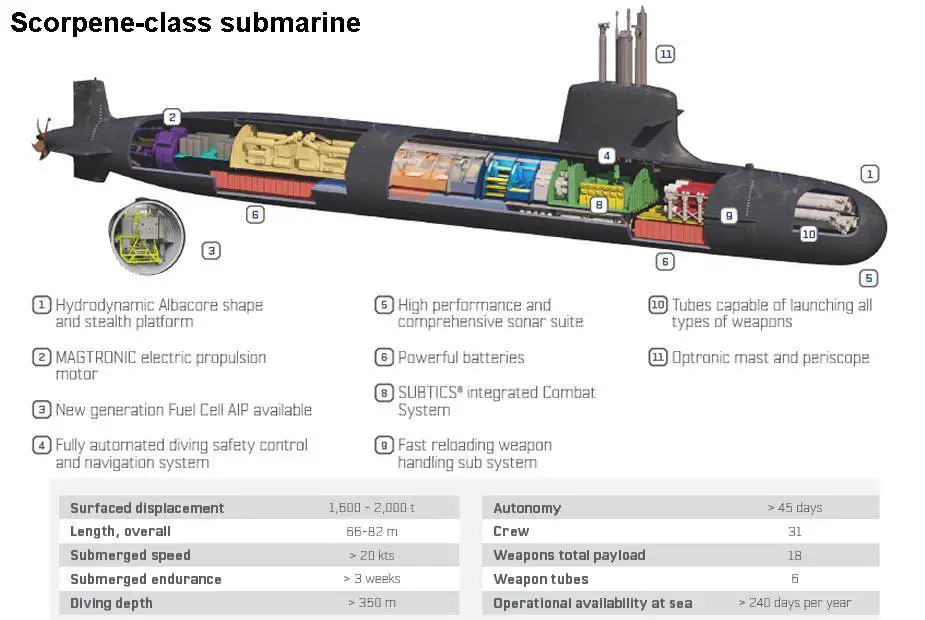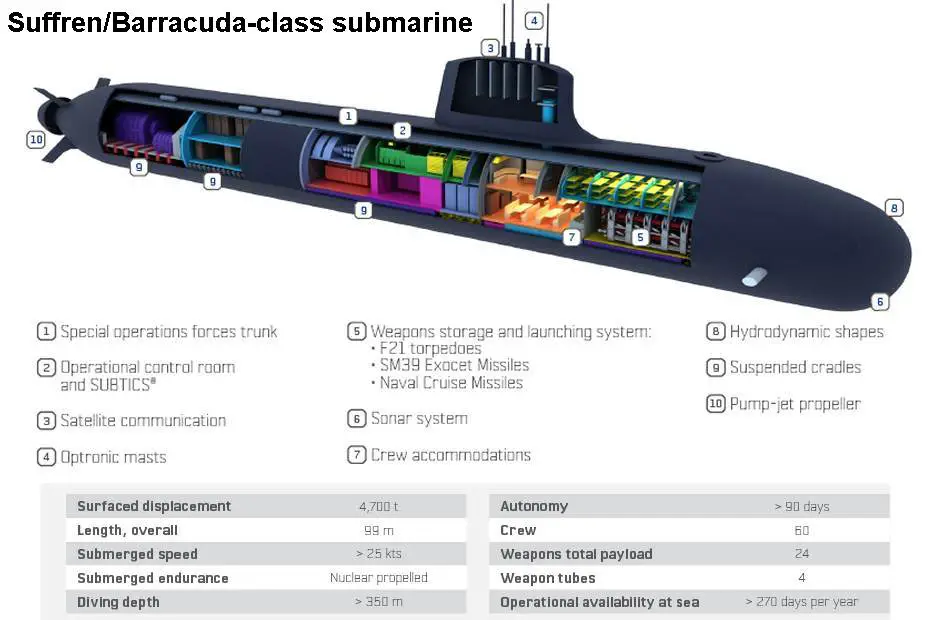French company Naval Group presents its full range of submarines at Euronaval Online, the digital edition of Euronaval 2020, International naval defense and maritime security industry exhibition. Naval Group has an effective offer in terms of conventional and nuclear-powered submarines including the Scorpène family, and Barracuda or Suffren-class.
French company Naval Group presents its full range of submarines at Euronaval Online, the digital edition of Euronaval 2020, International naval defense and maritime security industry exhibition. Naval Group has an effective offer in terms of conventional and nuclear-powered submarines including the Scorpène family, and Barracuda or Suffren-class.
 Naval Group Scorpene-class submarine technical review (Picture source naval Group)
Naval Group Scorpene-class submarine technical review (Picture source naval Group)
Naval Group is one of the most experienced submarine designers and builders in the world, having built more than 100 submarines for nine navies. The company has developed both conventional and nuclear submarines ranging from 2,000 tones up to 14,000 tones.
For the French Navy, Naval Group design and build the formidable Barracuda – a sophisticated submarine created to contest an ever-growing array of challenges. The first-in-class, the SSN Suffren, achieves integration of all of its equipment in the 2017 French summer, after which testing will begun, with sea trials commencing in 2019. The second boat, the Duguay Trouin, will follow the Suffren into assembly. Between 2017 and 2029, six Barracudas are set to replace the six Rubis/Améthyste-class boats currently in service.
The Scorpène submarine is capable of carrying out all types of missions, such as anti-surface vessel warfare, anti-submarine warfare, long-range strikes, special operations or intelligence gathering. It is extremely stealthy and fast, and is equipped with a comprehensive range of weapons (torpedoes, missiles, mines).
The Scorpène-class submarines are a class of diesel-electric attack submarines jointly developed by the French Company Naval Group (formerly DCNS) and the Spanish company Navantia. The Scorpène class of submarines has four subtypes including the CM-2000 conventional diesel-electric version, the AM-2000 air-independent propulsion (AIP) derivative, the downsized CA-2000 coastal submarine, and the enlarged S-BR for the Brazilian Navy, without AIP. The Scorpéne-class submarines are in service with Chile, Malaysia, India and Brazil. Over fourteen Scorpène submarines were sold by Naval Group internationally.
Citing Forecast International, The Scorpène hull design traces its lineage to the proposed diesel-electric version of the nuclear-powered Amethyste-class attack submarines. This design has been downsized to eliminate the size penalties that are automatically associated with nuclear power. The hull form itself is a derivative of the hydro-dynamically efficient Albacore design, with an extended parallel mid-ships section and rounded bow. The stern form is elongated and features fin-mounted hydroplanes and "+" shaped tailplanes.
Internally, the layout is very conventional, with two decks. The accommodations are on the upper deck, with the ship's diesel and batteries situated on the lower deck. The torpedo tubes are forward, firing out through the bow, with the sonar arrays in the chin position under the tubes. The ship has accommodations for 31 men, with a standard watch team of nine. The control room and the living quarters are mounted on an elastically supported and acoustically isolated floating platform. All living and operational areas are air-conditioned. The submarine also has space for six additional fold-down bunks for a special operations crew.
The Scorpène -class submarine has two diesel generation sets providing 1,250kW of power. At the top of the hull immediately above the diesel generator sets is a Dutch Breach machinery shipping hatch. The submarine has an elastically supported 2,900kW electronic engine.
The Scorpène submarine can carry 18 torpedoes and missiles or 30 mines. It is equipped with six bow-located 21in torpedo tubes providing salvo launch capability. Positive discharge launching is by an air turbine pump. It can launch anti-ship and anti-submarine torpedoes, as well as anti-surface missiles. The handling and loading of weapons are automated.

Naval Group Suffren/Barracuda-class submarine technical review (Picture source Naval Group)
The Barracuda/Suffren family of submarines brings unmatched oceanic potential to the market and offers uncompromised performance in acoustic discretion, special operations, stealth, and striking power. The ship allows the navies to operate far from their homeport, freely and safely while gathering valuable information without being detected. Resulting of a long investment in acoustic superiority inherited from the French SSBN, its robust design makes it the best attack submarine.
The Suffren is the first of the Barracuda-class series, designed to replace the six Rubis-class nuclear attack submarine operated by the French Navy. the first submarine of this class was commissioned in 1983. Naval Group is in charge of the construction of this submarine series, including the design and construction of the ship and information systems as well as the manufacturing of the main components of nuclear boiler rooms.
Naval Group is the overall prime contractor of the ship’s architecture (2 500 people) and TechnicAtome is the prime contractor for the nuclear reactor. The French Defence Procurement Agency (DGA) is in charge of the overall program, with the Atomic Energy and Alternative Energies Commission (CEA) for the nuclear reactor.
The Suffren is one of the stealthiest submarines over the world. This discretion, combined with its advanced detection capabilities, guarantees its acoustic superiority. For the first time thanks to the Suffren-class submarines, the French Navy will have a deep strike capability with MBDA's naval cruise missiles (MdCN). The latest generation of SSN also allows the discreet deployment of special forces underwater, in particular thanks to its "divers hatch" and the optional carrying of a dry deck shelter allowing for the deployment of underwater vehicles.
The Suffren/Barracuda-class submarine has a surface displacement of 4,700 tons with a length of 99 meters and a diameter of 8.8 meters. The submarine is propelled by a new hybrid design providing electric propulsion including two turbo reductors groups with 10 MW (13,000 hp) propulsion alternator feeding electric engines and nuclear reactor K15, developing 150 MW (200,000 hp). It can reach a maximum speed of 14 knots (26 km/h) when submerged and 25 knots (46 km/h) in underwater conditions. It has a crew of 65 people including officers and sailors and can accommodate a group of commando.
The Suffren/Barracuda-class submarine is armed with four 533mm torpedo tubes and accommodates 18 torpedo and missiles in a mixed load. The submarine can fire naval cruise missile Naval Scalp developed by MBDA, F-21 heavy-weight wire-guided torpedoes, and modernized Exocet SM39 anti-ship missiles.







